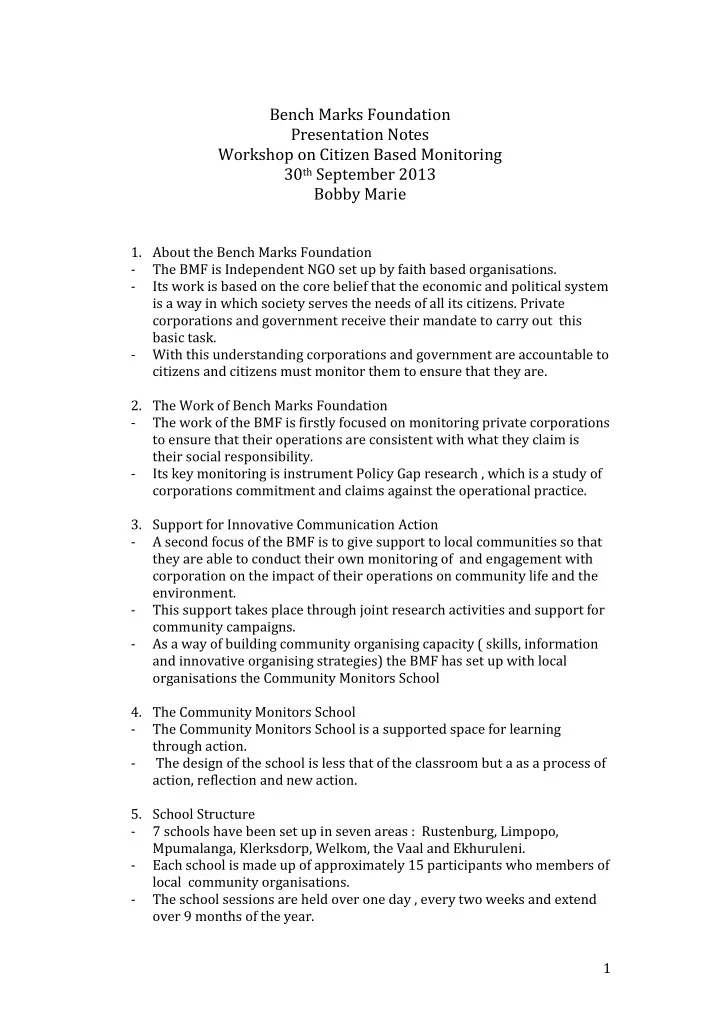

Bench Marks Foundation Presentation Notes Workshop on Citizen Based Monitoring 30 th September 2013 Bobby Marie 1. About the Bench Marks Foundation - The BMF is Independent NGO set up by faith based organisations. - Its work is based on the core belief that the economic and political system is a way in which society serves the needs of all its citizens. Private corporations and government receive their mandate to carry out this basic task. - With this understanding corporations and government are accountable to citizens and citizens must monitor them to ensure that they are. 2. The Work of Bench Marks Foundation - The work of the BMF is firstly focused on monitoring private corporations to ensure that their operations are consistent with what they claim is their social responsibility. - Its key monitoring is instrument Policy Gap research , which is a study of corporations commitment and claims against the operational practice. 3. Support for Innovative Communication Action - A second focus of the BMF is to give support to local communities so that they are able to conduct their own monitoring of and engagement with corporation on the impact of their operations on community life and the environment. - This support takes place through joint research activities and support for community campaigns. - As a way of building community organising capacity ( skills, information and innovative organising strategies) the BMF has set up with local organisations the Community Monitors School 4. The Community Monitors School - The Community Monitors School is a supported space for learning through action. - The design of the school is less that of the classroom but a as a process of action, reflection and new action. 5. School Structure - 7 schools have been set up in seven areas : Rustenburg, Limpopo, Mpumalanga, Klerksdorp, Welkom, the Vaal and Ekhuruleni. - Each school is made up of approximately 15 participants who members of local community organisations. - The school sessions are held over one day , every two weeks and extend over 9 months of the year. 1
- In between meetings participants engage in tasks which bring to the school sessions for reflection and feedback. 6. School programme In Phase One the focus is on building core skills through classroom exercises and fieldwork. In Phase Two participants practice their understanding and skills in a direct community action. Phase 1 Participants are introduced to key tools and skills for community activism. In the first phase - Writing with Power - Understanding Community and Environmental Problems - Information Gathering using visualisation tools - Analysis and Strategy Formulation - Reporting and Communications - Action Planning In the second phase participants working in small groups plan and implement an action related to a problem identified in Phase 1 exercises. 7. Communications, Networking and the Social Media - Activists learn to develop communication strategy using new media technology and platforms to communicate within and across communities and build solidarity networks globally 8. Advanced level training − Parallel to the community schools a smaller group of experienced activists drawn from community participate in an advanced level training programme where they develop skills in research analysis and using the internet and social media as an organising tool. − This programme in 2013 consisted of 6 workshops and was done in collaboration with trained professionals in social analysis, research and communication strategy. 9. Coordination and Facilitation - Each community school session is organised and administered by a facilitator drawn form the local organisation and trained by the BMF. The facilitator receives a monthly stipend and is paid for cell phone and Internet communication costs. - The programme is managed by a team of 4 coordinators who are BMF staff and an external education and organising resource person 10. Reflection on our experience - Community monitors work in a situation of conflict with business and government authorities. This arises largely from the attitude of disrespect shown by government agencies, local councilors and factory managers. 2
- Building grassroots community organisation is a slow and difficult process. The key problems are o The lack of resources (information, skills and finances) o The manipulative practices of local elites seeking to use community organisation for business and political advancement, and the authoritarian attitude of traditional leaders who feel threatened by independent organisations. 11. Lessons for government – Take grassroots community activists seriously – Avoid strategies of cooption, incorporation and manipulation – Discourage the use of community projects for Party campaigns – Create an enabling environment for the emergence and development of independent organisations. 12. Innovative ideas In giving support to independent citizen’s based monitoring, government should consider the following innovations” Facilitate community access to legal and technical experts in their • preparation for EIA’s , Commissions , and investigations into community problems Expand the public works programmes to include community monitoring • and support internships for community activists in advocacy organisations Open out government facilities such as meeting halls to community • groups Provide internet access to community groups via Post office and Libraries • Create structures such as a community CCMA where community activists • can easily and quickly bring cases against violations and corrupt behavior by corporations and government officials. 3
Recommend
More recommend